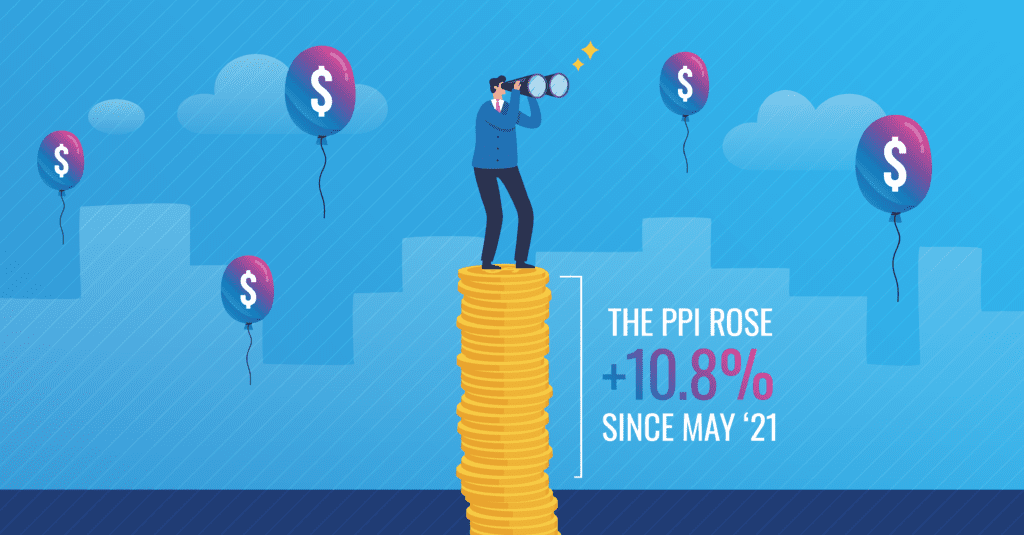How the Producer-Price Index (PPI) Impacts Your Business

Businesses are facing a number of challenges in the summer of 2022, including higher interest rates and an increase in the producer-price index (PPI). These challenges present an opportunity to managers who are willing to review business operations and to take action.
Automation is a tool managers can use to reduce operating costs, and limit the impact of higher prices. For example, Stampli’s AP Automation can sharply decrease the time and expense required to process accounts payable. Consider the recent news related to PPI.
Defining the Producer-Price Index
The US Bureau of Labor Statistics (BLS) calculates and reports changes in the producer-price index, a metric that measures what supplies are charging businesses and other customers. PPI is also referred to as a change in wholesale prices. Here is the May 2022 PPI data:
- The index rose a seasonally-adjusted .08% in May of 2022, and 10.8% for the 12 months ended in May ‘22.
- PPI measures price increases for both goods and services. Nearly two-thirds of the rise in the May index was due to prices for goods, with the remaining increase driven by the price of services.
- Energy prices, including gasoline were higher, along with the cost of transportation and warehouse services.
According to the Wall Street Journal: “May marked the sixth consecutive month of double-digit annual gains for producer prices.” Companies that purchase physical goods from suppliers- or ship physical products to customers- may be heavily impacted by the PPI increase.
The Federal Reserve (FED) attempts to reduce the increase in PPI by increasing interest rates. Specifically, the FED controls the federal funds rate, which is the rate that banks pay to borrow from each other overnight. When the federal funds rate changes, all other interest rates are affected. Higher interest rates make it more expensive to borrow money, and higher rates slow economic growth.
A number of factors are driving the PPI increase.
Factors That Drive the PPI Increase
The Federal Reserve has kept interest rates low during the coronavirus pandemic, and consumer demand for goods and services has outpaced supply. In addition, the war in Ukraine has led to commodity price increases for wheat, precious metals, and oil. Finally, China’s periodic COVID-19 lockdowns have continued to impact supply chain issues.
Managers are operating in an environment with higher interest rates, increased wholesale prices, and supply chain disruptions.
Reducing the Impact of PPI
Well-managed businesses are proactive, and take steps to reduce the impact of increasing prices. The strategies differ, depending on the company’s size, industry, and financial position. Consider whether or not these strategies apply to your business.
Passing on a price increase
The Wall Street Journal article discussed above explains that food suppliers and restaurants have been particularly hard hit by recent economic conditions. These firms are paying more for: “labor, packaging, ingredients and transportation. The rising cost of fuel is making it more expensive to produce and sell food.”
Many food suppliers and restaurants are passing on price increases to customers. Consumers are seeing higher prices at the grocery store, and on restaurant menus. Some restaurants are offering more limited menus, or reducing hours when carryout is available. These changes are in response to higher prices and labor shortages.
Consumers may be willing to pay higher prices, if they value your product or service, and see your business as different from the competition. If buyers feel differently, a price increase will result in lower sales and a loss of market share.
Carrying less inventory
Retailers and wholesalers incur large costs for inventory, which reduces available cash for other purposes. If inventory prices are increasing, some managers will simply reduce inventory to control spending.
Increasing competition and e-commerce offerings mean that your customers can buy the same product from a number of businesses. If you’re out of stock, or no longer carry a particular product, buyers may go elsewhere and not come back.
Managers must balance the cost savings of carrying less inventory with the potential for lost sales and disappointed customers.
Working more efficiently
Your best option may be to reduce operating costs to offset higher prices, and automation can help you lower business expenses. Think about the routine tasks that require staff time, and determine how much of each process can be automated. One common example is invoice processing and accounts payable.
Stampli’s end-to-end AP platform gives you full control and visibility over all your corporate spending from cards to invoices to payments — all in one place. Take control over invoice and bill processing with smart, intuitive, and actionable AP Automation.
By centering communications on top of the invoice itself, AP departments collaborate and communicate better with approvers, vendors, and any stakeholder involved with purchases, allowing approvals to happen 5x faster.
Position the Business for Success
The current business environment is challenging, but you can take action to minimize the impact of price increases. Take a hard look at each task you perform, and leverage automation to reduce costs. By taking action now, you’ll gain the advantage over competitors who are slow to respond. Don’t just manage spend, control it with Stampli.